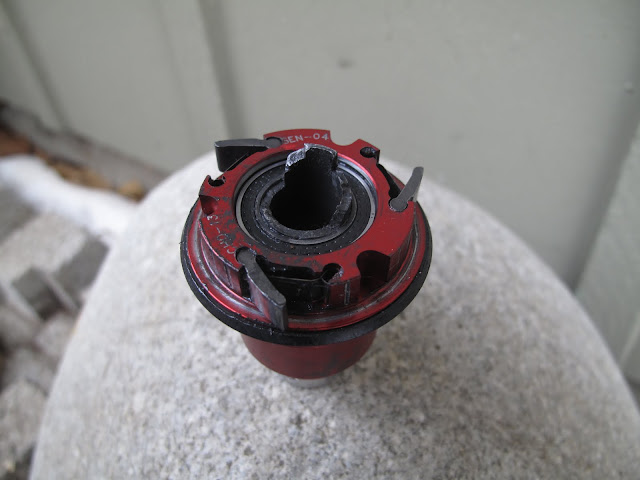The other day, a bright sparkling early winter day with a sprinkling of the icy bits, the HFC rode with friends to the top of a local favorite "
flow trail". Ingeniously built using (gnome) hands and machinery to allow even a moderately skilled rider to flow far above their actual abilities. After an easy "
typical government graded road" ride we arrived at the top, switched up clothes, had a snack, and dropped into the trail. Which opens with a wee pump up over a root ball. Which I intended to do. Pump up over the root ball. But, age, lack of skill, and a general lack of balls sent me in a bit slow so I had to pedal at the top.
But... wait! No chain! Now that's
odd... You see, this hasn't happened to the HFC but maybe once in two years since he switched to a 1x11 drivetrain with a clutch type derailleur. And that one time it was a small fir cone that got picked up by the rear wheel, carried round to the chain stay yoke, where it was peeled off the tire. Just in time to be picked up by the teeth of the crank and carried up into the chain, dumping said chain smoothly off the chainring.
So after checking for stray vegetation, I put the chain back on, turned around, and rode back up. I hit it again and... same thing. Although this time I notice an odd noise, like the rear fender rubbing on the rear tire. So back up for another try and... same. At 0 for 3 I put the chain back on and went on down the trail. Eventually I was able to see that every time I pumped a feature (crouched down and pushed off the pedals) the freehub would lock up and I would be riding a fixed gear. While locked, the cassette would then squirt chain towards the crank above the chain stay. As my weight came off the rear wheel the freehub would unlock and the derailleur tension would retrieve the squirted chain with an audible
zzzzzip-clack sound as the system came up snug. Pedaling before or during the retrieval would cause the chain to drop.
So while zooming along, try to adapt my rhythm to accommodate the gross shortcomings of my drivetrain, I found myself preoccupied with the question:
I had only two suspects: The freehub body, or a broken axle. But every freehub I've blown up (or seen blown up) simply turned into a full time fixed gear, none of this "it works great except when..." business.
And it did work great. Climbing seated, climbing standing, coasting mellow stuff, or even rock gardens. Worked just fine. Except when...
So I concluded that it must be a broken axle. The hub (Stan's 3.3 with XD driver) was set up with a 12x142mm axle system. Which was assembled plenty tight. And the wheel was still attached to the bike, so the 12mm axle wasn't broken. But, see that's that's not really the axle, the 12mm "axle" is an attachment system that could more rightfully be called a heavy duty skewer, just not a quick release one. The actual axle is the cylinder in the hub to which the bearings are attached and through which the 12mm axle slides. Because the 12mm "axle" is big and solid and strong I figured that it could be holding that hub together pretty well, even is the real axle was broken. However, the huge additional load (of a fat ass biker) pumping features could potentially cause the hub/axle to flex and jam the free-hub.
I finished up the ride, drove home, went to the LBS and was able to demonstrate the phenomena to him on the sidewalk in front of the shop. Interest piqued, the LBS dove in and tore it down to find: A broken axle
But why? Was it all about being Ham Fisted? Smashing ye olde hardtail into stuff? Going too big? Or was it just being too big? Too many chips? Too much chocolate?
Or maybe something else?
Well, there's this:
All those pawls and clicky bits all the set in the far end of the hub, and as soon as practical, the hub body narrows considerably. Compare that with, say, a Chris King:
Positively chubby. Because that makes it stiff and strong.
So there ya go.
Time to go buy some more chocolate.
Afterward
Six months after the HFC destroyed the Stans 3.3 hub he was railing corners on the new wheels when there was a loud CRACK followed immediately by some extra special rear wheel lockup. Closer inspection revealed that the Maxle (the same one that endured the broken hub and then been placed into service in the replacement wheel) had broken:
If worked for while, but was probably terminally damaged in the previous incident.



























